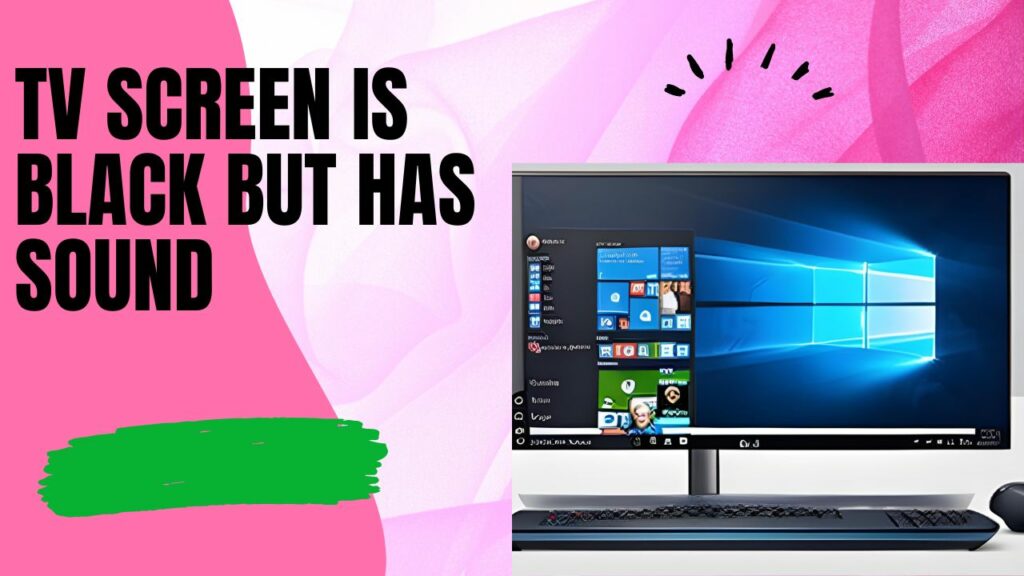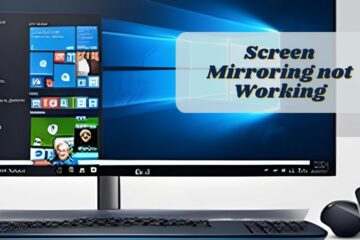Your TV is the centerpiece of your entertainment, and it can be frustrating when the screen goes black. There could be several reasons why your TV screen is black, ranging from physical issues to software problems and external factors. This article will explore the various causes of a black screen and provide troubleshooting steps and tips to resolve the issue.
Physical Issues
There are several physical issues that can cause a black screen on your TV, including power problems, physical damage, and loose connections.

Power issues
One of the most common reasons for a black screen on a TV is a power problem. Check the power cable, power supply, and electrical outlets to ensure that they are working correctly.
- Power cable: Check the power cable for any visible signs of damage or fraying. If there is damage, try replacing the cable.
- Power supply: If the power supply is damaged, it may need to be repaired or replaced.
- Electrical outlets: Make sure that the electrical outlet that the TV is connected to is working by plugging in another device and checking if it powers on.
Physical damage
Physical damage to the TV can cause a black screen. If the screen is cracked or scratched, it may need to be repaired or replaced. Additionally, internal damage may also be the cause, which requires professional assistance.
- Cracks or scratches: Check the screen for any visible damage. If there are cracks or scratches, the screen may need to be replaced.
- Internal damage: If there is no visible damage, but the TV screen is still black, there may be internal damage that requires professional repair.
Loose connections
Loose connections can also cause a black screen on your TV. Check all the cables, including HDMI or other cables, wall sockets, and antenna or cable connections.
- HDMI or other cables: Make sure that all the cables are securely plugged in and not loose.
- Wall sockets: Check the wall sockets to ensure that they are not damaged and the connection is secure.
- Antenna or cable connections: Check the antenna or cable connections to make sure they are securely plugged in.
Software Issues
Software issues can also cause a black screen on your TV. These issues include input selection, display settings, and firmware issues.
Input selection
If the TV screen is black, it may be because of the input selection. Make sure that you have selected the correct source and input.
- Source selection: Ensure that you have selected the correct source, such as HDMI or cable.
- Wrong input selection: Check if the input selection is correct. Make sure that you have selected the correct input for your device.

Display settings
The TV’s display settings can also cause a black screen. Adjust the display settings to fix the issue.
- Brightness and contrast: Adjust the brightness and contrast settings to see if it fixes the issue.
- Color calibration: Incorrect color calibration can cause a black screen. Check the color settings and adjust them if necessary.
- Aspect ratio: Ensure that the aspect ratio is set to the correct setting.
Firmware issues
Firmware issues can also cause a black screen. Check for firmware updates or corrupt firmware.
- Update problems: If the firmware update fails, it can cause a black screen. Check for updates and try updating again. You may also be faced with Screen Mirroring Work issues.
- Corrupt firmware: If the firmware is corrupt, it may need to be reinstalled or repaired.
External Factors
External factors can also cause a black screen on your TV. These factors include poor lighting conditions, obstruction of the signal, interference, and weather
Poor lighting conditions
Poor lighting conditions can also cause a black screen on your TV. Bright lights or reflections can make it difficult to see the screen.
- Light sources: Make sure there are no bright light sources reflecting off the screen, such as lamps or windows.
- Room lighting: Adjust the room lighting to reduce glare and improve visibility.
Obstruction of the signal
If the TV screen is black, it may be because of the obstruction of the signal. Ensure that there are no objects blocking the signal between the TV and the source.
- Obstructions: Check for any obstructions, such as furniture or walls, that may be blocking the signal.
Interference
Interference can also cause a black screen on your TV. This interference may be caused by other electronics or devices in the room.
- Electronic devices: Move any electronic devices away from the TV to see if it resolves the issue.
- Wireless signals: Check if there are any wireless signals, such as a Wi-Fi router, that may be interfering with the TV signal.
Weather
Weather conditions can also affect your TV signal, especially during storms or heavy rain.
- Weather interference: If the weather is affecting the TV signal, there may be no immediate solution other than waiting for the weather to clear up.
Troubleshooting Steps
If your TV screen is black, try the following troubleshooting steps to resolve the issue:
Power cycling
Turning off the TV and unplugging it from the power source for a few minutes can help reset the TV and resolve power-related issues.
- Power cycling: Turn off the TV and unplug it from the power source for a few minutes. After that, plug it in again and turn it on to check if the problem has been fixed.
Checking cables
A black screen on your TV can be caused by loose or damaged cables. Ensure that all cables connected to your TV are properly plugged in and not damaged.
- HDMI cables: Ensure that the HDMI cables are properly connected to the TV and the source device.
- Power cables: Check the power cable and make sure it is properly plugged in and not damaged.
Rebooting devices
Rebooting devices that are connected to your TV can help resolve issues related to software or firmware.
- Rebooting devices: Turn off the TV and all connected devices, unplug them from the power source for a few minutes, then plug them back in and turn them on to see if the issue is resolved.
Checking internet connection
If your TV is connected to the internet, check the internet connection to ensure that it is stable and working correctly.
- Internet connection: Check the internet connection on your TV by going to the network settings and checking the connection status.
Adjusting display settings
Incorrect display settings can cause a black screen on your TV. Ensure that the display settings are configured correctly for the input source.
- Display settings: Check the display settings on your TV and ensure that they are configured correctly for the input source.
Resetting to factory settings
Performing a factory reset on your TV can help resolve issues related to software or firmware.
- Factory reset: Perform a factory reset on your TV by following the instructions in the user manual.
If the issue persists after trying these troubleshooting steps, contact the manufacturer for assistance or seek professional repair services.
Additional Tips
Updating firmware
Firmware updates can fix bugs and improve performance. Check if there is an available firmware update for your TV and follow the instructions to update it.
- Firmware update: Check if there is an available firmware update for your TV and follow the instructions to update it.
Replacing damaged parts
If your TV screen is still black after trying all the troubleshooting steps, it may be due to a faulty part. Consider seeking professional repair services to replace any damaged parts.
- Professional repair: Contact the manufacturer or a certified repair technician for assistance in replacing any damaged parts.
Adjusting antenna or cable connections
If you use an antenna or cable to receive TV signals, ensure that the connections are secure and properly connected to avoid signal interference.
- Antenna or cable connections: Check the antenna or cable connections on your TV and ensure that they are properly connected and secure.
Using a surge protector
A power surge can damage your TV and cause a black screen. Use a surge protector to protect your TV from power surges.
- Surge protector: Use a surge protector to protect your TV from power surges.
Cleaning the TV screen
A dirty TV screen can cause image distortion and make it difficult to see the picture. Clean your TV screen regularly to ensure optimal viewing.
- Cleaning the TV screen: Use a microfiber cloth and a mild cleaning solution to clean your TV screen regularly.
When to Seek Professional Help
If you have tried all the troubleshooting steps and your TV screen is still black, it may be time to seek professional help. Here are some signs that it’s time to contact a professional:
No resolution to the problem after troubleshooting
If you have tried all the troubleshooting steps and your TV screen is still black, it may be due to a more serious issue that requires professional attention.
- No resolution: If there is no resolution to the problem after troubleshooting, it may be time to seek professional help.
DIY repairs may cause more harm than good
If you are not familiar with TV repair and attempt to fix the issue yourself, you may end up causing more harm than good. It is important to know your limits and seek professional help if necessary.
- DIY repairs: Attempting to fix the issue yourself may cause more harm than good. It is important to know your limits and seek professional help if necessary.
Professional repair service recommendations
Contact the manufacturer or a certified repair technician for assistance in resolving the issue. They can recommend professional repair services if necessary.
- Professional repair service recommendations: Contact the manufacturer or a certified repair technician for assistance in resolving the issue. They can recommend professional repair services if necessary.
Warranty or insurance coverage
If your TV is under warranty or has insurance coverage, it is important to contact the manufacturer or your insurance provider for assistance in resolving the issue.
- Warranty or insurance coverage: If your TV is under warranty or has insurance coverage, it is important to contact the manufacturer or your insurance provider for assistance in resolving the issue.
Also Read: Barndominium Plans with Shop – Redefining Home Living
Conclusion
In conclusion, a black screen on your TV can be caused by various factors, including physical, software, and external issues. Checking for these factors can help resolve the problem, but if the issue persists, there are troubleshooting steps that can be taken, such as power cycling the TV, performing a factory reset, or contacting the manufacturer for assistance. It is essential to ensure that your TV is in a suitable environment with proper lighting and no obstructions to avoid signal interference. If you experience a black screen on your TV, don’t panic, go through the necessary checks and troubleshooting steps, and if all else fails, seek professional repair services. By following these steps, you can ensure that your TV is back to its normal functioning and enjoy your favorite programs without interruptions.
FAQs
1. What is the most common reason for a black screen on a TV?
The most common reason for a black screen on a TV is a power problem, such as a damaged power cable or power supply.
2. Can software issues cause a black screen on a TV?
Yes, software issues can cause a black screen on a TV. These issues may include input selection, display settings, and firmware problems.
3. Can I stream content from my laptop to my TV wirelessly?
Yes, if your laptop and TV support Wi-Fi Direct or Miracast, you can connect your TV and laptop and also you can stream content wirelessly. Alternatively, you can use a streaming device like Chromecast or Roku to stream content from your laptop to your TV
4. Can external factors affect the TV signal?
Yes, external factors such as poor lighting conditions, obstruction of the signal, interference, and weather can affect the TV signal and cause a black screen.
5. What should I do if the troubleshooting steps do not resolve the issue?
If the troubleshooting steps do not resolve the issue, contact the manufacturer for assistance or seek professional repair services.



0 Comments